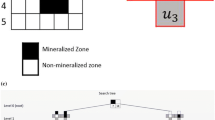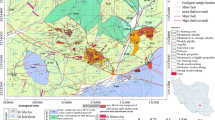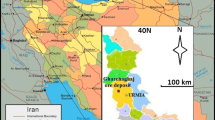Abstract
Mineral resource evaluation requires defining grade domains of an ore deposit. Common practice in mineral resource estimation consists of partitioning the ore body into several grade domains before the geostatistical modeling and estimation at unsampled locations. Many ore deposits are made up of different mineralogical ensembles such as oxide and sulfide zone: being able to model the spatial layout of the different grades is vital to good mine planning and management. This study addresses the application of the plurigaussian simulation to Sivas (Turkey) gold deposits for constructing grade domain models that reproduce the contacts between different grade domains in accordance with geologist’s interpretation. The method is based on the relationship between indicator variables from grade distributions on the Gaussian random functions chosen to represent them. Geological knowledge is incorporated into the model by the definition of the indicator variables, their truncation strategy, and the grade domain proportions. The advantages of the plurigaussian simulation are exhibited through the case study. The results indicated that the processes are seen to respect reproducing complex geometrical grades of an ore deposit by means of simulating several grade domains with different spatial structure and taking into account their global proportions. The proposed proportion model proves as simple to use in resource estimation, to account for spatial variations of the grade characteristics and their distribution across the studied area, and for the uncertainty in the grade domain proportions. The simulated models can also be incorporated into mine planning and scheduling.















Similar content being viewed by others
References
Alabert, F. (1987). Stochastic imaging of spatial distributions using hard and soft information (p. 198). Stanford, CA: Department of Applied Earth Sciences, Stanford University.
Armstrong, M., Galli, A., Le Loc’h, G., Geffroy, F., & Eschard, R. (2003). Plurigaussian simulations in geosciences. Berlin: Springer.
Betzhold, J., & Roth, C. (2000). Characterizing the mineralogical variability of a Chilean copper deposit using plurigaussian simulations. Journal of the South African Institute of Mining and Metallurgy, 100(2), 111–120.
Carle, S. F., & Fogg, G. E. (1996). Transition probability-based indicator geostatistics. Mathematical Geology, 28(4), 453–476.
Chiles, J. P., & Delfiner, P. (1999). Geostatistics: Modelling spatial uncertainty. New York: Wiley.
De Almeida, J. A. (2010). Stochastic simulation methods for characterization of lithoclasses in carbonate reservoirs. Earth-Science Reviews, 101(3–4), 250–270.
Deutsch, C. V. (2006). A sequential indicator simulation program for categorical variables with point and block data: BlockSIS. Computers and Geosciences, 32, 1669–1681.
Deutsch, C. V., & Journel, A. G. (1997). GSLIB: Geostatistical software library and user’s guide (Applied Geostatistics Series) (2nd ed.). New York: Oxford University Press.
Dowd, P. A., Pardo-Igúzquiza, E., & Xu, C. (2003). Plurigau: A computer program for simulating spatial facies using the truncated plurigaussian method. Computers and Geosciences, 29(2), 123–141.
Emery, X., Ortiz, J. M., & Cáceres, A. M. (2008). Geostatistical modeling of rock type domains with spatially varying proportions: Application to a porphyry copper deposit. Journal of the South African Institute of Mining and Metallurgy, 108, 285–292.
Eurasian Minerals Inc. (2009). Technical report on the exploration results and resource estimates for the Sisorta property Sivas province, Turkey (unpublished).
Fontaine, L., & Beucher, H. (2006). Simulation of the Muyumkum uranium roll front deposit by using truncated plurigaussian method. In Proc of the 6th international mining geology conference, “Rising the challenge”, Darwin, Australia.
Georgsen, F., & Omre, H. (1993). Combining fibre processes and Gaussian random functions for modelling fluvial reservoirs. In A. Soares (Ed.), Geostatistics Tróia’92 (pp. 425–440). Dordrecht: Kluwer.
Hedenquist, J., & White, N. (2005). Epithermal gold deposits, PDAC short course.
Lantuéjoul, C. (2002). Geostatistical simulation: Models and algorithms. Berlin: Springer.
Le Loc’h, G., & Galli, A. (1997). Truncated plurigaussian method: Theoretical and practical points of view. In E. Y. Baafi & N. A. Schofield (Eds.), Geostatistics Wollongong ‘96 (Vol. 1, pp. 211–222). Dordrecht: Kluwer.
Mariethoz, G., Renard, P., Cornaton, F., & Jaquet, O. (2009). Truncated plurigaussian simulations to characterize aquifer heterogeneity. Ground Water, 47(1), 13–24.
Miranda, J., Deraisme, J., & Rojas, O. (2010). Sampling optimization of a volcano-sedimentary deposit using geostatistical simulations. In IV international conference on mining innovation, Santiago, Chile.
Mustafa, C., & Keskin, O. (1999). Mining geology report of Evliya Tepe (Ortakent-Koyulhisar-Sivas). Mineral Research & Exploration General Directorate (MRE) Report No. 10217 (in Turkish) Ankara (unpublished).
Newton, A. (2005). Sisorta PIMA alteration study, ABX memorandum with 4 maps. ABX (unpublished).
Ortiz, J. M., & Emery, X. (2006). Geostatistical estimation of mineral resources with soft geological boundaries: A comparative study. Journal of the South African Institute of Mining and Metallurgy, 106(8), 577–584.
Remacre, A. Z., & Zapparolli, L. H. (2003). Application of the plurigaussian simulation technique in reproducing lithofacies with double anisotropy. Revista Brasileira de Geociencias, 33(2), 13–24.
Rondon, O. (2009). A look at plurigaussian simulation for a nickel laterite deposit. In 7th international mining & geology conference, Perth, Australia.
Seifert, D., & Jensen, J. L. (1999). Using sequential indicator simulation as a tool in reservoir description. Issues and Uncertainties, 31(5), 527–550.
Soares, A. (2001). Direct sequential simulation and cosimulation. Mathematical Geology, 33(8), 911–926.
Strebelle, S. (2002). Conditional simulation of complex geological structures using multiple-point statistics. Mathematical Geology, 34(1), 1–22.
Vigar, A. J., Meldrum, S., Giroux, G., & Soylu, M. (2009). Technical report on exploration results and resource estimates for the Sisorta property Sivas province, Turkey. By Mining Associates Pty. Limited for Chesser Resources Limited and Eurasian Minerals Inc (unpublished).
Acknowledgments
The authors are grateful to Eurasian Minerals, Inc. (“EMX”) for providing the dataset used in this study. This research was partly funded by the Scientific Research Projects Unit of Çukurova University (Turkey) through the project number MMF2010BAP14. The anonymous reviewer’s comments are gratefully acknowledged.
Author information
Authors and Affiliations
Corresponding author
Rights and permissions
About this article
Cite this article
Yunsel, T.Y., Ersoy, A. Geological Modeling of Gold Deposit Based on Grade Domaining Using Plurigaussian Simulation Technique. Nat Resour Res 20, 231–249 (2011). https://doi.org/10.1007/s11053-011-9150-4
Received:
Accepted:
Published:
Issue Date:
DOI: https://doi.org/10.1007/s11053-011-9150-4




